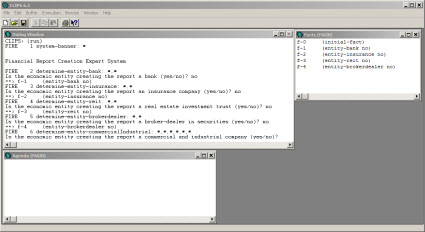Using CLIPS to Understand Expert Systems and Logic Programming
CLIPS is a tool for building expert systems originally developed by NASA. Since it was first released in 1986 it has undergone significant enhancements and was put into the public domain by NASA in about 2002. CLIPS continues to be maintained as public domain software.
Here is documentation and other information that will help get you started with CLIPS should you have the curiosity:
- CLIPS website
- Download CLIPS 6.3
- YouTube Video Introduction to CLIPS, gets you familiar with the software interface and basics related to using the tool
- CLIPS Tutorial (three parts)
- CLIPS Documentation
- Users Guide which provides an elementary introduction to expert systems for people with little or no experience with expert systems.
- Basic Programming Guide
With that documentation above, I had a working expert system in about 4 hours. Here you go:
What my first expert system does is help someone understand what reporting style a financial report needs to be based on information about the economic entity creating a financial report. It is not complete yet, but I was able to learn a lot and am off to a good start.
If you want to understand expert systems, CLIPS is an excellent investment. Right off the bat you learn the different between a declarative programming language and a procedural language. I explain the importance of this difference in my document Complete Introduction to Business Rules for Professional Accountants (page 7). You will learn why business rules should be declarative, not procedural.
Another thing you learn is the difference between different programming paradigms. Understanding logic programming helps you see that software programs can be broken into two parts: the logic component and the control component.
Why does all this matter? It matters because it helps you understand (a) that you don't need to understand how to code to get a computer to do work for you; and (b) separating logic and control makes maintenance of things easier.
If none of this make sense to you, please read the document Comprehensive Introduction to Knowledge Engineering for Professional Accountants.
References (1)
-
 Response: majedaar hum
Response: majedaar hum


Reader Comments